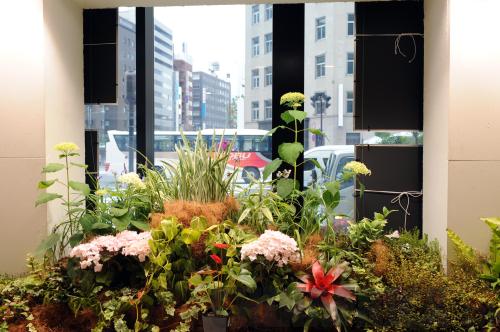|
 |
|
Plants can cheaply gauge and improve indoor air quality MA PING |
Heavy smog shrouded China's central and eastern regions for days this past January, and experts are advising citizens to stay inside.
But how much safer is our indoor air? The U.S. Environmental Protection Agency's research shows that 24 million people in the world die every year as a result of poor indoor air quality, said Song Guangsheng, Secretary General of China's Indoor Environment Test Center (CIETC).
Many factors contribute to bad indoor air quality – chemical contaminants, such as formaldehyde from interior decoration materials, biological pollutants such as germs and bacteria, and physical impurities floating in the air, such as PM2.5 particles, Song added.
Here are some practical tips for improving indoor air quality. Save your lungs from the air you breathe at home.
» Buy air purifiers
There has recently been a boom in the sales of air purifiers and particle-proof masks. Mr. Xu, a customer service representative from Philips Electronics, said that the company is currently selling more than 1,000 purifiers a week online.
The purifiers have two main functions – absorbing PM2.5 and sterilizing air. Many machines on the market can do both. They can be purchased in electronics stores, such as Suning or Gome, or ordered online from popular net merchants such as Taobao.com, 360buy.com or Newegg.com.
The first thing to do is to check the machine's functions and coverage area, and then choose a model that best fits your needs.
But purifiers don't come cheap. Prices range from thousands of yuan to tens of thousands. When working with a limited budget, consider buying a small, handy and cheaper air purifier. Although much less effective than the higher-end models, these range from tens to hundreds of yuan.
Purifiers must be regularly cleaned to function as promised. Filters should be routinely changed. Using an air purifier and a humidifier at the same time is also recommended.
» Lay out activated charcoal products
Activated charcoal products are widely acknowledged to be good at absorbing benzene, formaldehyde, ammonia and other harmful elements in the air, as well as bad smells.
There are many types and sizes of charcoal packs on the market. Usually the package offers recommendations on where to place them, such as on shelves, in drawers or on the floor. Choose according to your needs.
After a while, take the packs out and expose them to sunlight for a few hours to reactivate the charcoal.
» Grow plants
You can't get much more natural than plants. According to CIETC, green plants are great at reducing floating dust in the air. It's best to choose big plants with big leaves. About 62 percent of particles that can be inhaled are absorbed during photosynthesis.
Of course, your plants can also tell you how healthy your indoor air is. Dead or yellow leaves are not a good sign.
Chemical fragrances can cover up smells and create the illusion of fresh air, but they are not good for your health. Fresh flowers and bowls of fruit are smarter ways to freshen up your living or work space.
» Open windows
To open the windows or not – that's the dilemma that many face on gray, smoggy days. You want to keep pollution out, but indoor air can become stale and stagnant without circulation.
Don't open windows at times when pollution spikes, especially the early morning. Hours with more sunshine are better, and Song suggested keeping windows open for one or two hours.
Keep an eye on the air quality reports, and decide when to open the windows accordingly.
» Food helps
Although many disagree with the idea that certain foods can offset the effects of pollution, traditional Chinese medicine teaches that dark vegetables can nourish blood vessels, and red foods can help cleanse the lungs. Therefore, indulge in black fungus, black beans and red jujubes as much as possible during these dark days.
(Source: Global Times)
|